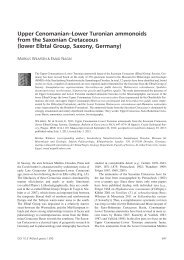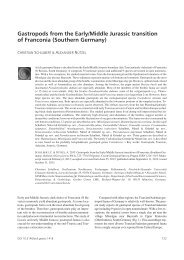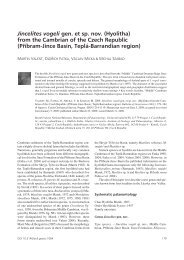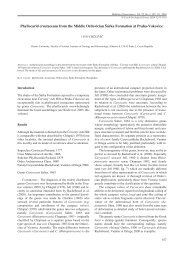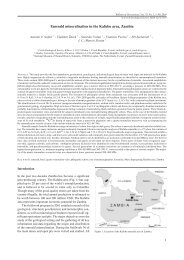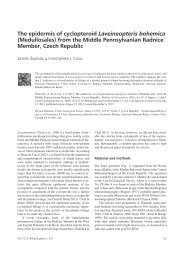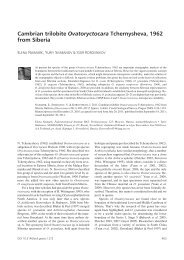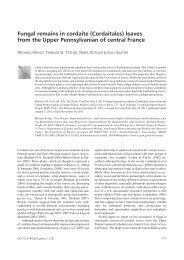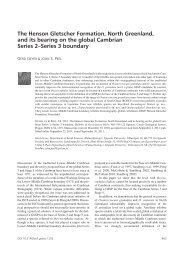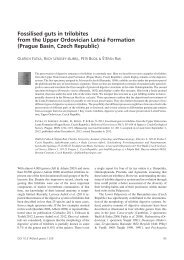Provenance study of Permian non-marine sandstones and ...
Provenance study of Permian non-marine sandstones and ...
Provenance study of Permian non-marine sandstones and ...
Create successful ePaper yourself
Turn your PDF publications into a flip-book with our unique Google optimized e-Paper software.
This <strong>study</strong> focuses on identifying major source areas in several stratigraphic intervals in the <strong>Permian</strong> sediments <strong>of</strong> the<br />
Krkonoše Piedmont Basin <strong>and</strong> integrates it with existing sedimentological data. Pebbles in Cisuralian–Guadalupian<br />
conglomerates <strong>of</strong> alluvial fans, nearshore lacustrine <strong>and</strong> lacustrine fan-delta deposits that were deposited close to the<br />
northwestern <strong>and</strong> southeastern basin margin, respectively, correspond almost exclusively to local material from adjacent<br />
crystalline complexes. The heavy mineral associations <strong>of</strong> the s<strong>and</strong>stone matrix <strong>of</strong> these conglomerates support this interpretation.<br />
Crystalline units <strong>of</strong> the south-western part <strong>of</strong> the Krkonoše-Jizera Crystalline Complex <strong>and</strong> Orlice-Sněžník<br />
Crystalline Complex, respectively, are considered as the most favourable sources. Heavy mineral associations <strong>of</strong> fluvial<br />
s<strong>and</strong>stone facies are <strong>of</strong> complex composition pointing to repeated recycling <strong>of</strong> clastic material. However, heavy mineral<br />
indices reveal distinct source areas for the main lithostratigraphic units. Two main possible source areas for the fluvial<br />
Asselian deposits (Vrchlabí Formation) <strong>of</strong> the south-western part <strong>of</strong> the basin were found. Pebbles <strong>of</strong> late Devonian–early<br />
Carboniferous <strong>marine</strong> limestones probably came from the central part <strong>of</strong> the hypothetical Jítrava-Hradec Basin.<br />
The garnet compositions in s<strong>and</strong> detrital material point to leucogranites <strong>and</strong> pegmatites <strong>of</strong> the north-eastern<br />
Moldanubian Zone, Přibyslavice area, as the possible source rocks. Guadalupian fluvial deposits reveal a wide range <strong>of</strong><br />
sources that can be attributed to the recycling <strong>of</strong> detrital material from Cisuralian <strong>and</strong> Carboniferous deposits. Garnet<br />
compositions indicate Moldanubian granulites, garnet clinopyroxenites, leucogranites <strong>and</strong> pegmatites as a possible<br />
sources. We infer that Moldanubian granulites <strong>and</strong> garnet clinopyroxenites were exposed to an erosion level in the Early<br />
<strong>Permian</strong> at the latest. • Key words: provenance, Krkonoše Piedmont Basin, <strong>Permian</strong>, heavy minerals, pebble composition,<br />
detrital garnet composition.<br />
MARTÍNEK,K.&ŠTOLFOVÁ, K. 2009. <strong>Provenance</strong> <strong>study</strong> <strong>of</strong> <strong>Permian</strong> <strong>non</strong>-<strong>marine</strong> <strong>s<strong>and</strong>stones</strong> <strong>and</strong> conglomerates <strong>of</strong> the<br />
Krkonoše Piedmont Basin (Czech Republic): exotic <strong>marine</strong> limestone pebbles, heavy minerals <strong>and</strong> garnet composition.<br />
Bulletin <strong>of</strong> Geosciences 84(3), 555–568 (8 figures, 2 tables). Czech Geological Survey, Prague. ISSN 1214-1119. Manuscript<br />
received May 15, 2006; accepted in revised form January 26, 2009; published online August 13, 2009; issued September<br />
11, 2009.<br />
Karel Martínek, Institute <strong>of</strong> Geology <strong>and</strong> Palaeontology, Charles University, Albertov 6, 128 43 Prague 2, Czech Republic;<br />
karel@natur.cuni.cz • Kateřina Štolfová, School <strong>of</strong> Geological Sciences, University College Dublin, Belfield,<br />
Dublin 4, Irel<strong>and</strong><br />
Conglomerate pebble composition can be a good indicator<br />
<strong>of</strong> adjacent source areas in basin studies, but it usually does<br />
not provide information on more distant sources <strong>of</strong> detrital<br />
material. A heavy mineral association (HMA) from <strong>s<strong>and</strong>stones</strong><br />
<strong>and</strong> a s<strong>and</strong>stone conglomerate matrix can indicate more<br />
distant sources. In areas with complex source rock lithologies<br />
(igneous, low-grade <strong>and</strong>/or medium-grade metamorphics,<br />
volcanics), the HMA can <strong>of</strong>ten contain mixed provenance<br />
information that is not easy to interpret. An effective<br />
method for discriminating the specific source areas could be<br />
integrating palaeocurrent data with a detailed mineral chemistry<br />
determination using an electron microprobe (e.g.,<br />
<br />
Morton 1985, Owen 1987, Morton 1991). Garnets with a<br />
potentially wide range in composition show significant differences<br />
in composition among different types <strong>of</strong><br />
garnet-bearing lithologies (Čopjaková et al. 2005). Another<br />
advantage <strong>of</strong> garnet for provenance studies is its relative stability<br />
during diagenesis (Morton & Hallsworth 1999).<br />
The aims <strong>of</strong> this <strong>study</strong> include determining the source<br />
areas <strong>of</strong> the Vrchlabí <strong>and</strong> Trutnov formations <strong>of</strong> the Krkonoše<br />
Piedmont Basin based on pebble composition, heavy<br />
mineral assemblages, <strong>and</strong> detrital garnet compositions. Additionally,<br />
previously acquired palaeocurrent data obtained<br />
by conventional sedimentological methods are integrated.
Simplified geological map <strong>of</strong> the Krkonoše Piedmont Basin (KPB) with sample locations. Inset map: outline <strong>of</strong> <strong>non</strong>-<strong>marine</strong> Permo-Carboniferous<br />
basins (hash) <strong>and</strong> KPB (black hash). Outcrop samples: Bel – Bělá, Brd – Brodky, Crm – Čermná, Haj – Hajnice, HP – Honkův potok,<br />
Hra – Hrádeček, JDv – Janský Dvůr, KU – Kundratice, N9, NSh, N8 – Náchod, N11 – Dolní Radechová, N310, N311, N313, N314 – Náchod-Běloves,<br />
N14 – Havlovice, PL – Prostřední Lánov, Rsk – Roškopov, SP – Stará Paka Railway Station, T21 <strong>and</strong> T22 – Pekelský vrch, TrP – Trutnov-Poříčí,<br />
T2 – Trutnov – Starý Rokytník, U13 – Suchovršice, U8, 9, 10, 12 – Úpice, Zbr – Záboří.<br />
The composition <strong>of</strong> detrital garnets from fluvial Early Triassic<br />
deposits <strong>of</strong> Bohdašín Formation is also discussed.<br />
<br />
The Krkonoše Piedmont Basin formed as part <strong>of</strong> a system<br />
<strong>of</strong> extensional/transtensional, intermontane basins during<br />
the post-Variscan period (Asturian–Triassic, Fig. 1). There<br />
has been systematic geological research on the Late Carboniferous–Triassic<br />
basin fill during the last several decades.<br />
This research was mainly based on geological mapping <strong>and</strong><br />
several structural boreholes were also made. The lithostratigraphic<br />
concept <strong>of</strong> the basin was established by Tásler et<br />
al. (1981), Tásler & Prouza (1985), <strong>and</strong> a summary <strong>of</strong> this<br />
research was presented by Prouza & Tásler (2001). The<br />
provenance <strong>of</strong> selected sedimentary units was determined<br />
by Prouza & Tásler (2001) based mainly on the pebble<br />
composition <strong>of</strong> conglomerates. They suggest the following<br />
sources <strong>of</strong> the clastic material:<br />
1. for the Stará Paka S<strong>and</strong>stone (Vrchlabí Formation):<br />
<br />
material eroded from the underlying Semily Formation<br />
(the presence <strong>of</strong> cherts <strong>and</strong> tuffs <strong>of</strong> Ploužnice Stephanian C<br />
age, cropping out in the western part <strong>of</strong> the basin);<br />
2. Horní Město Member (Trutnov Formation): material<br />
transported from the north (the pebbles composed almost<br />
entirely <strong>of</strong> Krkonoše-Jizera Crystalline Complex rocks –<br />
crystalline limestone (dominant, up to 90%), quartzite,<br />
lydite, gneiss, mica shist, granitoid; Upper Palaeozoic<br />
volcanites <strong>and</strong> sediments are rare);<br />
3. for the Náchod Conglomerates (Trutnov Formation):<br />
material transported from the south (based on the<br />
presence <strong>of</strong> pebbles <strong>of</strong> Orlice-Sněžník Crystalline Complex<br />
– phyllite, granite, granite porphyry, crystalline<br />
limestone, quartzite).<br />
Pebble composition provides basic information on the<br />
provenance <strong>of</strong> local, coarse-grained, shortly transported<br />
material <strong>and</strong> did not allow distant source areas to be determined.<br />
Novák et al. (1983) analysed heavy minerals <strong>of</strong> the<br />
Vrchlabí Formation from ZŽ-1 borehole. They found a<br />
poor HMA that varied little with a predominance <strong>of</strong> zircon,<br />
tourmaline, monazite <strong>and</strong> with sporadic occurrence <strong>of</strong>
magnetite, apatite, garnets <strong>and</strong> Cr spinel, assuming lowgrade<br />
metamorphic <strong>and</strong> acid igneous source rocks.<br />
Sedimentological research has been conducted recently<br />
(Blecha et al. 1999, Martínek 2003, Martínek et al. 2006),<br />
but palaeocurrent analysis gives only limited information<br />
on provenance, because <strong>of</strong> the limited amount <strong>of</strong> suitable<br />
outcrops, <strong>and</strong> the difficulties in correlating important outcrops.<br />
Basin-wide unconformities (Fig. 2) <strong>and</strong> changes in<br />
the thicknesses <strong>of</strong> sedimentary units indicate substantial<br />
shifting <strong>of</strong> depocentres at the Stephanian B/C (mid<br />
Gzhelian) <strong>and</strong> Autunian/Saxonian (Lower/Upper Rotliegende,<br />
Cisuralian/Guadalupian) boundaries that led to<br />
changes in basin configuration. The depocentres were<br />
shifting from the south to the north at the Stephanian B/C<br />
boundary, which was noted, e.g., by Pešek (1994, 2005) as<br />
a common feature in Central <strong>and</strong> Western Bohemian Carboniferous–<strong>Permian</strong><br />
sedimentary basins. The shift in<br />
depocentre location was interpreted as a switching <strong>of</strong> the<br />
major displacement from southern to northern marginal<br />
faults still in an extensional half-graben setting (Uličný et<br />
al. 2002, Martínek et al. 2006). At the Cisuralian/Guadalupian<br />
boundary a major tectonic rearrangement <strong>of</strong> the<br />
basin occurred, probably from an extensional to a<br />
strike-slip regime (Uličný et al. 2002).<br />
Palaeocurrent analysis <strong>of</strong> the fluvial <strong>s<strong>and</strong>stones</strong> <strong>of</strong> the<br />
Vrchlabí Formation (Asselian) at the south-western part <strong>of</strong><br />
the Krkonoše Piedmont Basin reveals dominant NNE<br />
trending palaeocurrent vectors (Štolfová 2004). Fluvial<br />
<strong>s<strong>and</strong>stones</strong> <strong>of</strong> the Trutnov Formation (Guadalupian), deposited<br />
after major unconformity in the eastern part <strong>of</strong> the<br />
basin, show a low spread <strong>of</strong> palaeocurrent vectors trending<br />
to the north <strong>and</strong> northeast (Martínek 2003). Very similar<br />
north-eastern trends <strong>of</strong> fluvial <strong>s<strong>and</strong>stones</strong> <strong>of</strong> the Trutnov<br />
Formation were observed in the adjoining south-western<br />
part <strong>of</strong> the Intrasudetic Basin (Lojka 2003). This is in<br />
agreement with Prouza & Tásler (2001) who suggested a<br />
single depositional area covering the eastern part <strong>of</strong> the<br />
Krkonoše Piedmont Basin (Trutnov-Náchod Subbasin)<br />
<strong>and</strong> Intrasudetic Basin during the Guadalupian.<br />
<br />
<br />
The individual methods used in provenance studies have different<br />
significance <strong>and</strong> are influenced by a number <strong>of</strong> factors<br />
that complicate the recognition <strong>of</strong> provenance. Therefore a<br />
complex approach integrated the modal composition <strong>of</strong> <strong>s<strong>and</strong>stones</strong><br />
<strong>and</strong> the typology <strong>of</strong> quartz grains <strong>of</strong> <strong>s<strong>and</strong>stones</strong> (23<br />
samples from Vrchlabí Formation, 42 samples from Trutnov<br />
Formation), pebble composition data (15 beds <strong>of</strong> 5 outcrops<br />
from the Vrchlabí Formation, 9 beds <strong>of</strong> 8 outcrops from the<br />
Trutnov Formation were inspected), heavy mineral analysis<br />
(67 samples), <strong>and</strong> garnet composition (5 rock samples,<br />
which correspond to 43 grains <strong>and</strong> 150 spot analyses).<br />
Stratigraphical chart <strong>of</strong> the <strong>Permian</strong> <strong>and</strong> Triassic <strong>of</strong> the<br />
Krkonoše Piedmont Basin based on the borehole Pé-1 in the centre <strong>of</strong> the<br />
basin (Asselian–Cisuralian) <strong>and</strong> on the compiled stratigraphy <strong>of</strong> the Trutnov-Náchod<br />
Subbasin (Guadalupian–Triassic, Prouza & Tásler 2001).<br />
Time values in Ma from Haq (2007).<br />
Modal composition was studied using st<strong>and</strong>ard petrological<br />
optical microscopy with semiquantitative estimates<br />
<strong>of</strong> each component. Pebble composition was determined at<br />
outcrops using lithology identification <strong>of</strong> all pebbles in<br />
1 square meter <strong>of</strong> vertical outcrop section <strong>of</strong> each bed.<br />
Heavy mineral assemblages provide the main database that<br />
was further processed to separate provenance-specific features<br />
<strong>and</strong> to eliminate other factors. The main sample set<br />
was taken from outcrops <strong>of</strong> the Vrchlabí <strong>and</strong> Trutnov formations,<br />
<strong>and</strong> several samples were also taken from the surrounding<br />
units. Sample location is indicated in Fig. 1, sample<br />
age in Table 1 (see electronic Appendix A). Heavy<br />
mineral samples were processed by the laboratories <strong>of</strong> the<br />
Czech Geological Survey, Prague. Heavy minerals were
separated from the s<strong>and</strong> fraction sieved below 0.5 mm<br />
(70 g samples) using heavy liquids (tetrabromethane<br />
C 2H 2Br 4, 2.95 g/cm 3 ) from disintegrated, washed <strong>and</strong> dried<br />
s<strong>and</strong>stone samples (2–5 kg field specimens). Individual<br />
minerals were identified using a st<strong>and</strong>ard petrologic optical<br />
microscope; X-ray diffraction <strong>and</strong> electron microprobe<br />
analyses were carried out where necessary for proper mineral<br />
identification. The chemical composition <strong>of</strong> garnet<br />
was determined by electron microanalysis. Analyses were<br />
carried out at the Laboratory <strong>of</strong> Electron Microscopy <strong>and</strong><br />
Microanalysis (Charles University in Prague) using a<br />
CamScan S4 scanning electron microscope with an energy<br />
dispersive analytical system Oxford instruments LINK<br />
ISIS 300. The beam current was 7 nA. Accelerating voltage<br />
was 20 kV. Acquisition time was 170 seconds. The energy<br />
resolution <strong>of</strong> the EDS spectra was 72 eV. The analysis was<br />
corrected by using the conventional ZAF correction<br />
method (Z = atomic number factor, A = absorption factor,<br />
F = characteristic fluorescence correction) to quantify the<br />
spectra. Mg, Al, Si, Ca, Ti, Cr, Mn, Fe <strong>and</strong> V were analysed<br />
with following detection limits: MgO (0.21 wt.%),<br />
Al 2O 3 (0.19 wt.%), SiO 2 (0.18 wt.%), CaO (0.10<br />
wt.%), TiO 2 (0.08 wt.%), V 2O 5 (0.13%), Cr 2O 3 (0.08<br />
wt.%), MnO (0.08 wt.%), FeO (0.13 wt.%). The SPI Supplies<br />
53 Minerals St<strong>and</strong>ard Set #02753-AB was used for<br />
routine quantitative calibration.<br />
<br />
<br />
The <strong>study</strong> was focused mainly on the pebble <strong>and</strong> modal<br />
composition <strong>of</strong> the Vrchlabí Formation fluvial deposits,<br />
where exotic limestone pebbles were found <strong>and</strong> where information<br />
on the source areas was scarce. The source areas<br />
are expected south <strong>of</strong> the basin, according to palaeocurrents<br />
(Štolfová 2004), <strong>and</strong> are mostly covered by Late Cretaceous<br />
deposits.<br />
The provenance analysis <strong>of</strong> fluvial deposits <strong>of</strong> the<br />
Vrchlabí Formation is based on the modal composition <strong>of</strong><br />
<strong>s<strong>and</strong>stones</strong>, the pebble composition <strong>of</strong> conglomerates <strong>and</strong><br />
the typology <strong>of</strong> the quartz grains. Identification <strong>of</strong> rock<br />
composition is based on a h<strong>and</strong> specimen <strong>and</strong> a thin section<br />
<strong>study</strong>. Conglomerates are oligomictic to polymictic in nature<br />
with pebble <strong>and</strong> cobble sizes ranging from 0.5 to<br />
16 cm. Pebbles <strong>of</strong> quartzite, para- <strong>and</strong> orthogneiss, lydites<br />
<strong>and</strong> acid volcanics are common. Clasts <strong>of</strong> metamorphic<br />
rocks are well rounded, generally better than the other pebbles.<br />
S<strong>and</strong>stones are mainly composed <strong>of</strong> quartz grains<br />
(58–82 vol.%) with variable rounding <strong>and</strong> levels <strong>of</strong> preservation.<br />
The grains are sub-angular to sub-oval <strong>and</strong> commonly<br />
replaced by calcite cement. Quartz grains are interpreted<br />
in terms <strong>of</strong> four possible origins: plutonic,<br />
<br />
low-grade metamophic, high-grade metamorphic <strong>and</strong> volcanic<br />
(Basu et al. 1975). Plagioclase <strong>and</strong> K-feldspar usually<br />
range from 2 to 12 vol.%. The individual samples<br />
show low variability in feldspar content. Carbonate cement<br />
<strong>and</strong> plutonic quartz are found in all samples, the original<br />
mud-rich matrix is rarely preserved. The presence <strong>of</strong> biotite,<br />
which breaks down easily due to its mechanical <strong>and</strong><br />
chemical instability, points to a very close source area, possibly<br />
the adjacent Zvičina Crystalline Unit (adjacent to basin<br />
margin south-east <strong>of</strong> Nová Paka). Metamorphic rock<br />
fragments, mostly altered phyllites, quartzitic phyllites <strong>and</strong><br />
quartzites, are probably derived from underlying Carboniferous<br />
deposits; they are very similar to material from the<br />
Krkonoše-Jizera <strong>and</strong> Zvičina crystalline complexes (Kachlík<br />
2004, pers. comm.). Acid volcanic rock fragments probably<br />
have their origin in the southern part <strong>of</strong> the Krkonoše<br />
Piedmont Basin.<br />
In the outcrops <strong>of</strong> the Stará Paka Railway Station locality,<br />
five pebbles <strong>of</strong> shallow <strong>marine</strong> limestone were found in<br />
fluvial <strong>s<strong>and</strong>stones</strong>. These pebbles occur in several beds <strong>and</strong><br />
their size ranges from 3 to 5 cm in diameter. They contain<br />
abundant bioclasts, both intact <strong>and</strong> fragmented, <strong>of</strong> open<br />
<strong>marine</strong> <strong>and</strong> shallow water carbonate origin. The rich faunal<br />
assemblage includes foraminifers, ostracods, brachiopods,<br />
molluscs, sponge spicules <strong>and</strong> less abundant crinoids,<br />
echinoderms <strong>and</strong> calcispheres (Fig. 3). Limestone is highly<br />
recrystallized, originally probably biomicritic. Interestingly,<br />
some <strong>of</strong> the elongated bioclasts, which are interpreted<br />
as algae, are silicified <strong>and</strong> infilled by bitumen.<br />
The preserved benthic foraminifers in these <strong>marine</strong><br />
limestone pebbles have a more complex test shape than<br />
those known from Early <strong>and</strong> Middle Devonian strata<br />
(Poiarkov 1969). However, the test shapes are not as complex<br />
as those typical for fusulinids <strong>of</strong> the Late Carboniferous<br />
<strong>and</strong> <strong>Permian</strong> times (Tappan & Loeblich 1988; Kalvoda<br />
1990, 2002). Hence we conclude that the foraminifers<br />
probably fall within the Late Devonian (late Famennian) to<br />
Early Carboniferous (Tournaisian–Viséan) age interval.<br />
Other abundant fossils such as ostracods, brachiopods,<br />
molluscs <strong>and</strong> calcispheres are difficult to identify precisely,<br />
because <strong>of</strong> the diagenetic overprint <strong>of</strong> the limestones,<br />
mainly neomorphism, <strong>and</strong> are therefore poor indicators<br />
<strong>of</strong> exact limestone age. The identification <strong>of</strong> algae<br />
remnants, with solid bitumen inclusions <strong>and</strong> the occurrence<br />
<strong>of</strong> spheroidal or oval fossils, which have a thick outer<br />
wall, remain problematic. The diverse assemblage <strong>of</strong> organisms<br />
<strong>and</strong> their abundance points to a normal salinity environment.<br />
The occurrence <strong>of</strong> the benthic foraminifers <strong>and</strong><br />
other organisms listed above suggests an open <strong>marine</strong> shelf<br />
or epicontinental sea environment in a tropical or subtropical<br />
climate.<br />
Modal <strong>and</strong> pebble composition <strong>of</strong> other samples <strong>of</strong> the<br />
Trutnov Formation point to local crystalline rock sources<br />
that are known from previous works (summarized in
Photomicrographs <strong>of</strong> limestone pebbles from the Vrchlabí Formation, locality Stará Paka Railway Station. •A–limestone silicification.<br />
Microquartz (MQ) replacing calcite spar (C). Crossed nicols, scale bar 0.5 mm. •B–bioclast or intraclast is surrounded by organic matter (black).<br />
Crossed nicols, scale bar 0.2 mm.•C–theforaminifers have more cells than foraminifers <strong>of</strong> Lower <strong>and</strong> Middle Devonian age. They have more complicated<br />
forms that are more typical <strong>of</strong> foraminifers from the Carboniferous or uppermost Devonian. Crossed nicols, scale bar 0.4 mm.•D–theshell <strong>of</strong> a<br />
mollusc or brachiopod is filled by calcite spar, whereas foraminifer is partly silicified (top right). Crossed nicols, scale bar 0.5 mm.•E–aphotomicrograph<br />
showing details <strong>of</strong> another foraminifer, at its right side the shell wall is well preserved (arrow). Parallel nicols, scale bar 0.8 mm.•F–ostracod shell<br />
(O) <strong>and</strong> elongated fragments <strong>of</strong> unknown origin (algae?). Parallel nicols, scale bar 1.2 mm.
Prouza & Tásler 2001). Therefore these results are not presented<br />
or discussed in this <strong>study</strong>.<br />
<br />
Heavy minerals are subject to a varying rate <strong>of</strong> alteration<br />
<strong>and</strong> disintegration during weathering in the source area,<br />
transport to the basin, weathering during periods <strong>of</strong> alluvial<br />
storage on the floodplain, diagenesis during burial, <strong>and</strong><br />
weathering at the outcrop <strong>of</strong> sedimentary rock. These processes<br />
significantly affect the proportions <strong>of</strong> individual<br />
heavy minerals found in the sedimentary record, which can<br />
differ from the proportions <strong>of</strong> accessory minerals in the<br />
source area. Haughton et al. (1991), Morton & Hallsworth<br />
(1994, 1999) discussed the factors influencing heavy mineral<br />
composition <strong>and</strong> Morton & Hallsworth (1994, 1999)<br />
isolated provenance-sensitive features, <strong>and</strong> avoided parameters<br />
that are influenced by other factors. The mineral<br />
indices proposed by these authors can eliminate transport/weathering/diagenetic<br />
modifications. Such an approach<br />
is successful in identifying provenance. The results<br />
obtained are summarized in Fig. 4, where detrital heavy<br />
minerals are plotted.<br />
The major components <strong>of</strong> the heavy mineral association<br />
found in most samples are zircon, apatite, tourmaline<br />
<strong>and</strong> garnet. These minerals could originate from a wide<br />
range <strong>of</strong> possible source rocks: metamorphic, plutonic,<br />
volcanic, either from the adjacent Krkonoše-Jizera Crystalline<br />
Complex or many other source rocks south <strong>of</strong> the basin.<br />
Cretaceous <strong>marine</strong> sedimentary rocks cover some<br />
potential source areas south <strong>of</strong> the studied basin, which are<br />
therefore not accessible for direct <strong>study</strong>. The provenance-specific<br />
minerals presented in Fig. 4 are not abundant<br />
in all samples. For example, in conglomerates deposited<br />
close to the basin margin (Náchod <strong>and</strong> Horní Město<br />
conglomerates) rock fragments (quartzite, phyllite, highly<br />
altered – Fe-oxidized – phyllite) <strong>and</strong> Fe oxides predominate<br />
in the heavy fraction. The interpretation <strong>of</strong> the relative<br />
proportions <strong>of</strong> the individual heavy minerals in the samples,<br />
where the sum <strong>of</strong> these selected provenance-specific<br />
minerals is less than 5–10% <strong>of</strong> the total HMA, must be<br />
done very carefully. There may be significant errors in calculating<br />
the relative proportions <strong>of</strong> minerals. Several distinct<br />
HMA, which are also supported by distinct heavy<br />
mineral (HM) indices, were found (Fig. 5). Stephanian C<br />
samples from the north-western part <strong>of</strong> the basin have an<br />
association <strong>of</strong> monazite-tourmaline-gahnite that is similar<br />
to Cisuralian samples from the north-western <strong>and</strong><br />
north-central parts <strong>of</strong> the basin, while Cisuralian samples<br />
from the south-western part <strong>of</strong> the basin (near Stará Paka,<br />
samples SPxyz, Fig. 5A) have a different association dominated<br />
by pyroxene-ilmenite-rutile-tourmaline-garnet.<br />
Sakmarian samples Crm <strong>and</strong> Zbr belong to the Prosečné<br />
<br />
Formation, they have a very simple mineral association<br />
dominated by tourmaline. The lower part <strong>of</strong> Guadalupian<br />
deposits is characterised by an ilmenite-rutile-tourmaline<br />
association, while Upper Guadalupian deposits have an ilmenite-rutile-tourmaline-garnet<br />
association. Kyanite <strong>and</strong><br />
staurolite were also found sporadically. They occur in the<br />
fluvial <strong>s<strong>and</strong>stones</strong> <strong>of</strong> the Trutnov <strong>and</strong> Vrchlabí formations.<br />
The RuZi (100 × TiO 2 group/TiO 2 group + zircon), GZi<br />
(100 × garnet/garnet + zircon) <strong>and</strong> ATi (100 × apatite/apatite<br />
+ tourmaline) HM indices <strong>of</strong> Morton & Hallsworth (1999)<br />
give other provenance specific information. On the GZi/ATi<br />
plot (Fig. 5) the distinct composition for the Horní Město<br />
<strong>and</strong> Náchod conglomerates, the Čistá S<strong>and</strong>stone, the upper<br />
part <strong>of</strong> the Havlovice S<strong>and</strong>stone, the Prosečné Formation<br />
<strong>and</strong> the last group with similar heavy mineral composition<br />
including Kumburk <strong>and</strong> Semily formations (Pennsylvanian),<br />
Stará Paka S<strong>and</strong>stone, Rudník Member, <strong>and</strong> the lower<br />
part <strong>of</strong> Havlovice S<strong>and</strong>stone were recognized.<br />
<br />
An effective method for discriminating specific source areas<br />
is detailed mineral chemistry determination using an electron<br />
microprobe (Morton 1985, Owen 1987, Morton 1991).<br />
Garnet composition was successfully used for the provenance<br />
<strong>study</strong> <strong>of</strong> clastic material <strong>of</strong> the Early Carboniferous<br />
forel<strong>and</strong> Culm Basin deposits <strong>of</strong> the Moravo-Silesian Zone<br />
at the eastern margin <strong>of</strong> the Bohemian Massif (Čopjaková et<br />
al. 2005). The results <strong>of</strong> garnet electron microprobe analyses<br />
from the Krkonoše Piedmont Basin (<strong>Permian</strong>–Triassic) are<br />
summarized in Figs 6, 7, selection <strong>of</strong> representative analyses<br />
are presented also in Table 2 (see electronic Appendix B).<br />
Garnet separation was carried out on 15 samples representing<br />
the main stratigraphic units. Unfortunately, many samples<br />
contain garnet grains <strong>of</strong> small size, <strong>and</strong> they are highly<br />
weathered. Only 5 samples contained garnet grains <strong>of</strong> size<br />
<strong>and</strong> preservation suitable for electron microprobe analysis.<br />
They included one sample <strong>of</strong> Asselian <strong>and</strong> Triassic, respectively,<br />
<strong>and</strong> three samples <strong>of</strong> Guadalupian age.<br />
Sample SPU-1 (Fig. 7, one grain was analysed) comes<br />
from the fluvial <strong>s<strong>and</strong>stones</strong> <strong>of</strong> the Vrchlabí Formation,<br />
Asselian, the Stará Paka railway station locality, the same<br />
locality from which Devonian/Carboniferous <strong>marine</strong> limestone<br />
pebbles were described. Dominant spessartine (0.7)<br />
composition with very low alm<strong>and</strong>ine (0.15), grossular<br />
(0.05) <strong>and</strong> pyrope (0.01) components. The absence <strong>of</strong><br />
zonality is characteristic.<br />
Samples U13 (Figs 6 <strong>and</strong> 7, six grains were analysed) are<br />
from the upper part <strong>of</strong> the fluvial s<strong>and</strong>stone unit <strong>of</strong> the<br />
Trutnov Formation (Guadalupian, locality Suchovršice –<br />
Adamov near Úpice), Unit 3B sensu Martínek (2003). Most<br />
garnet grains are dominated by alm<strong>and</strong>ine (0.45–0.65), have<br />
high pyrope (0.25–0.45), low grossular (less than 0.1) <strong>and</strong>
Detrital heavy minerals. Only heavy minerals considered as primary <strong>and</strong> derived from source rocks are presented. Rock fragments, carbonates,<br />
muscovite, biotite/phlogopite <strong>and</strong> diagenetic <strong>and</strong> other secondary minerals are not included. Carboniferous rocks represent <strong>s<strong>and</strong>stones</strong> <strong>and</strong> a s<strong>and</strong>stone<br />
matrix <strong>of</strong> conglomerates; sampled crystalline rocks include low grade metamorphics.<br />
very low spessartine components (less than 0.05). Zonality<br />
is absent. Anomalous very high alm<strong>and</strong>ine (0.70) <strong>and</strong> low<br />
pyrope (0.09) grain (U13-T1-2); <strong>and</strong> very high xMg garnet<br />
also occurs (U13-T1-4, up to 0.50 pyrope).<br />
Samples T2-3-T1 (Figs 6 <strong>and</strong> 7, 13 grains analysed) are<br />
from fluvial <strong>s<strong>and</strong>stones</strong> <strong>of</strong> the Trutnov Formation (Trutnov-Starý<br />
Rokytník, Unit 3B). Most grains (8) are <strong>of</strong> alm<strong>and</strong>ine<br />
(0.65–0.8) – pyrope (0.25–0.05) composition with<br />
variable grossular (0.05–01) <strong>and</strong> spessartine (0.15–less<br />
than 0.05). Two spessartine (0.4–0.45) – alm<strong>and</strong>ine<br />
(0.35–0.38) dominated grains have a grossular component<br />
<strong>of</strong> 0.1–0.2. Three grains are pyrope (0.6–0.38) – alm<strong>and</strong>ine<br />
(0.1–0.38) dominated with grossular <strong>of</strong> 0.15–0.25, one <strong>of</strong><br />
these grains (T2-3-T1-45) has 0.6 pyrope <strong>and</strong> 0.1 uvarovite<br />
(Cr garnet). Garnets T2-3-T1-06 <strong>and</strong> T2-3-39 have a<br />
prograde chemical zonality preserved with a high xMg<br />
value in the rim (0.35–0.45 pyrope, 0.3–0.6 alm<strong>and</strong>ine,<br />
0.2–0.1 grossular).<br />
Sample T21-21-1 (Fig. 7, one grain was analysed) comes<br />
from the Horní Město Conglomerates <strong>of</strong> the Trutnov Forma-<br />
tion, alluvial fan deposits forming a narrow (up to 1 km)<br />
fringe along the northern margin <strong>of</strong> the Trutnov-Náchod<br />
Subbasin (north <strong>of</strong> Vlčice <strong>and</strong> Trutnov). Conglomerate pebbles<br />
are composed <strong>of</strong> local material from the Krkonoše-Jizera<br />
Crystalline Complex (Prouza & Tásler 2001),<br />
but the garnet sample is from a s<strong>and</strong>stone matrix, which can<br />
contain material from more distal sources. In addition, a major<br />
unconformity at the base <strong>of</strong> the Trutnov Formation was<br />
accompanied by significant tectonic rearrangement <strong>of</strong> the<br />
basin (Uličný et al. 2002) that caused uplift <strong>and</strong> erosion <strong>of</strong><br />
older strata. Clasts <strong>of</strong> Stephanian C age within the Trutnov<br />
Formation are reported by Prouza & Tásler (2001). A dominant<br />
alm<strong>and</strong>ine (0.6)-spessartine (0.2) composition with low<br />
xMg, Ca <strong>and</strong> the absence <strong>of</strong> zonality was found.<br />
In samples Hajn (Figs 6 <strong>and</strong> 7, locality Hajnice, Bohdašín<br />
Formation, Early Triassic, fluvial red bed “Bunts<strong>and</strong>stein”<br />
facies, 22 grains) alm<strong>and</strong>ine (0.7–0.55)-pyrope<br />
(0.2–0.45) garnets with variable grossular (0.05–0.15) <strong>and</strong><br />
very low spessartine (less than 0.05) prevail (14 grains).<br />
Five grains are alm<strong>and</strong>ine (0.6–0.8) dominated with a low
The heavy mineral indices <strong>of</strong> Morton & Hallsworth (1999)<br />
point to distinct source rocks <strong>of</strong> individual lithostratigraphical units.<br />
grossular (0.05–0.1) <strong>and</strong> variable spessartine (0–0.2) component.<br />
Two grains are pyrope (0.42–0.45) dominated with<br />
alm<strong>and</strong>ine (0.35–0.38), grossular (0.21–0.23) <strong>and</strong> very low<br />
spessartine (less than 0.05). Most pyrope-alm<strong>and</strong>ines have<br />
flat pr<strong>of</strong>iles. In garnets Hajn3 <strong>and</strong> Hajn23 a weak prograde<br />
zonality can be observed. There is a slight increase in xMg<br />
from the core to the rim (see Figs 7, 8). Only grain Hajn18<br />
has a higher pyrope (0.45) component (0.35 alm<strong>and</strong>ine,<br />
0.2 grossular).<br />
Although there is a wide variety in garnet composition<br />
among the studied samples, some could be grouped according<br />
to similarities in composition. The high xMg garnet<br />
<strong>of</strong> U13-T1-4 (up to 0.50 pyrope) is similar to<br />
T2-3-T1-37, T2-3-T1-39 <strong>and</strong> Hajn18 (pyrope 0.45, alm<strong>and</strong>ine<br />
0.35, grossular 0.2). Alm<strong>and</strong>ine-pyrope garnets <strong>of</strong><br />
T2-3-T1 (0.65–0.45 alm<strong>and</strong>ine, 0.45–0.25 pyrope) have a<br />
composition similar to sample U13. A dominant alm<strong>and</strong>ine<br />
(0.6)-spessartine (0.2) composition with high Mn <strong>and</strong> low<br />
xMg, Ca <strong>and</strong> the absence <strong>of</strong> zonality is characteristic for<br />
the samples T21-21-1, T2-3-T1-32 <strong>and</strong> SPU-1.<br />
<br />
Based on the provenance-specific clastic materials found<br />
in the samples studied, we discuss possible source areas for<br />
particular stratigraphic units. Where direct evidence is missing,<br />
we comment on the possibility <strong>of</strong> other source areas.<br />
The conglomerates <strong>of</strong> alluvial fan deposits, which were deposited<br />
close to the basin margin, contain almost exclusively<br />
local material in the pebbles (e.g., Semily Formation<br />
near Semily; Lánov Conglomerates near Vrchlabí, Vrchlabí<br />
Formation; Horní Město Conglomerates near Trutnov,<br />
Trutnov Formation; Náchod Conglomerates near Náchod,<br />
Trutnov Formation). Our findings are consistent with the<br />
interpretations <strong>of</strong> Prouza & Tásler (2001).<br />
<br />
<br />
We describe, for the first time, the occurrence <strong>and</strong> composition<br />
<strong>of</strong> exotic <strong>marine</strong> limestone pebbles within the fluvial<br />
<strong>s<strong>and</strong>stones</strong> <strong>of</strong> the Vrchlabí Formation. Palaeocurrent data<br />
indicate a sediment supply from the south or southwest <strong>of</strong><br />
the Krkonoše Piedmont Basin. As stated above the most likely<br />
age <strong>of</strong> this limestone is Upper Devonian or Lower<br />
Carboniferous. We consider the deposits <strong>of</strong> the Jítrava-<br />
Hradec Basin (sensu Čech et al. 1989) to be the most likely<br />
source <strong>of</strong> pebbles. This hypothetical sedimentary basin is<br />
known only from relics in which <strong>marine</strong> deposits <strong>of</strong> Late<br />
Devonian <strong>and</strong> Early Carboniferous age occur. Deposits are<br />
preserved only in the Ještěd area (near Jítrava) <strong>and</strong> in several<br />
boreholes near Hradec Králové. Upper Devonian to<br />
Lower Carboniferous in situ <strong>marine</strong> limestone was encountered<br />
in the Nepasice borehole near Hradec Králové. Stromatoporoids,<br />
foraminifers <strong>and</strong> algae <strong>of</strong> probable Upper Famenian<br />
age (Zukalová 1976) were found in the limestone<br />
samples taken from the base <strong>of</strong> the carbonate sequence. A<br />
specimen <strong>of</strong> rugose coral was also found <strong>and</strong> its age is Late<br />
Famennian (Galle 1976). In the Nepasice borehole, the limestone<br />
sequence has some features in common with the<br />
development <strong>of</strong> the Ještěd area, but its appearance <strong>and</strong> fossil<br />
content is most similar to the Devonian <strong>of</strong> Moravia, namely<br />
the Moravian Karst facies (Chlupáč & Zikmundová<br />
1976). It can also be correlated to Dzikowiec in the<br />
Klodzko region, Pol<strong>and</strong> (Gluszek & Tomas 1994). The limestones<br />
<strong>of</strong> the Jítrava area are <strong>of</strong> Famennian age <strong>and</strong> contains<br />
a trilobite <strong>and</strong> conodont fauna. They are organic matter<br />
rich in places <strong>and</strong> may represent a mid to deeper shelf<br />
<strong>marine</strong> environment (Chlupáč 1964, 1997). Although the<br />
fossil content <strong>of</strong> the limestone pebbles from the Stará Paka<br />
Railway Station locality corresponds with neither the Nepasice<br />
nor the Jítrava occurrence (Kalvoda 2004, pers.<br />
comm.), the age <strong>of</strong> the deposits correspond well. The<br />
source <strong>of</strong> limestone pebbles could be in the central part<br />
<strong>of</strong> the Jítrava-Hradec Basin, where, unfortunately, the sedimentary<br />
record <strong>of</strong> this age is not known. This area is extensively<br />
covered by Pennsylvanian <strong>non</strong>-<strong>marine</strong> <strong>and</strong> Late<br />
Cretaceous <strong>marine</strong> deposits, but Devonian/Carboniferous<br />
deposits could have also been eroded during the Mississipian/Pennsylvanian<br />
tectonostratigraphic rearrangement <strong>of</strong><br />
the area.<br />
<br />
The stratigraphic significance <strong>of</strong> HMA <strong>and</strong> their usage for<br />
outcrop correlation within the Trutnov Formation is discussed<br />
elsewhere (Martínek 2003). This <strong>study</strong> is focused<br />
on the interpretation <strong>of</strong> possible source areas. The HM<br />
composition <strong>of</strong> most samples is highly complex <strong>and</strong> it is<br />
not easy to extract provenance-specific information from.
Boundaries <strong>of</strong> the main lithostratigraphic units are marked<br />
with changes in HMA (Fig. 5A, B). The similarity in the association<br />
<strong>of</strong> monazite-tourmaline-gahnite in the Stephanian<br />
C samples from the north-western part <strong>of</strong> the basin<br />
<strong>and</strong> Cisuralian samples from north-western <strong>and</strong> northcentral<br />
parts <strong>of</strong> the basin point to the existence <strong>of</strong> a similar<br />
source area for this part <strong>of</strong> the basin during the Stephanian<br />
C <strong>and</strong> Cisuralian. Samples are mostly from basin margin<br />
clastics (alluvial fan, nearshore lacustrine, lacustrine<br />
fan-delta facies). Monazite is not very significant, but it is<br />
abundant in granitoids <strong>and</strong> orthogneisses. Gahnite was not<br />
described thus far from either the marbles or metapelites <strong>of</strong><br />
the Krkonoše-Jizera Crystalline Complex, but some<br />
calc-silicate rocks <strong>of</strong> contact metamorphic zones are possible<br />
c<strong>and</strong>idates; gahnite is known from the Staré Město<br />
Crystalline Complex <strong>and</strong> the Moldanubian Zone. Tourmaline<br />
is abundant in the phyllites <strong>and</strong> shists <strong>of</strong> the Krkonoše-Jizera<br />
<strong>and</strong> Zvičina crystalline complexes. Possible<br />
source areas include some units <strong>of</strong> the south-western part<br />
<strong>of</strong> the Krkonoše-Jizera Crystalline Complex or overlying<br />
units that have been eroded away.<br />
Cisuralian samples from the south-western part <strong>of</strong> the<br />
basin have a different association dominated by pyroxeneilmenite-rutile-tourmaline-garnet.<br />
Samples come from fluvial<br />
facies <strong>of</strong> the Vrchlabí Formation, for which<br />
palaeocurrents indicate transport from the south. Source<br />
areas <strong>of</strong> the fluvial <strong>s<strong>and</strong>stones</strong> could be more distant. More<br />
information is needed to determine particular units <strong>of</strong> the<br />
central <strong>and</strong> southern Bohemian Massif as possible source<br />
areas (see discussion <strong>of</strong> garnet composition below). The<br />
simple mineral association (dominated by tourmaline) <strong>of</strong><br />
the Sakmarian samples (Crm <strong>and</strong> Zbr belonging to the<br />
Prosečné Formation) could be explained in terms <strong>of</strong> destruction<br />
<strong>of</strong> less stable heavy minerals. Unstable heavy<br />
minerals were probably disintegrated <strong>and</strong> weathered due<br />
to a prolonged exposure on the floodplain. The Prosečné<br />
Formation is characterised by a low-gradient alluvial-lacustrine<br />
system with low subsidence rates <strong>and</strong> a semi-arid<br />
climate (Martínek 1995, Prouza & Tásler 2001), <strong>and</strong><br />
long-time exposure <strong>of</strong> sediments on the floodplain is expected.<br />
The stratigraphy <strong>of</strong> garnet-free <strong>and</strong> garnet-rich<br />
units <strong>of</strong> the Guadalupian is discussed in Martínek (2003) in<br />
detail. It could be concluded that a major change in source<br />
areas is expected at the mid-Guadalupian basin-wide unconformity.<br />
Changes in HM composition <strong>of</strong> various stratigraphic<br />
units point to tectonic <strong>and</strong> tectonostratigraphic<br />
changes in source areas that correlate with tectonosedimentary<br />
changes within the basin. At least the<br />
Cisuralian/Guadalupian unconformity, but probably also<br />
Stephanian B/C <strong>and</strong> mid-Guadalupian unconformities,<br />
could be correlated with these changes. Minerals pointing<br />
to more distant sources are kyanite <strong>and</strong> staurolite. These<br />
minerals occur in the fluvial <strong>s<strong>and</strong>stones</strong> <strong>of</strong> the Trutnov <strong>and</strong><br />
Vrchlabí formations that have palae<strong>of</strong>lows directed to the<br />
north <strong>and</strong> northeast. Kyanite <strong>and</strong> staurolite do not occur in<br />
either the adjacent Krkonoše or Zvičina crystalline complexes.<br />
The closest occurrence <strong>of</strong> such minerals is in the<br />
Orlice-Sněžník granulites or Moldanubian metamorphics.<br />
<br />
Garnet SPU-1 with a dominant spessartine (0.7) composition<br />
with very low alm<strong>and</strong>ine (0.15), grossular (0.05) <strong>and</strong><br />
pyrope (0.01) components <strong>and</strong> an absence <strong>of</strong> zonality is interpreted<br />
as probably coming from a magmatic source; garnets<br />
from leucocratic granites <strong>and</strong> pegmatites can have a similar<br />
composition. Mn rich garnets are described e.g., by<br />
Breiter (2005) from orthogneisses, pegmatites <strong>and</strong> granites<br />
near Přibyslavice, the NE part <strong>of</strong> the Moldanubian Zone<br />
(7–15 wt.% MnO). Alternatively, very similar garnet<br />
(0.6 Sps, 0.15 Grs, 0.15 Alm) with an absence <strong>of</strong> zoning<br />
also occurs in the blueschists <strong>of</strong> the eastern part <strong>of</strong> the<br />
Krkonoše-Jizera Crystalline Complex in Sněžný potok<br />
near Žacléř (Žáčková 2006 pers. comm.). Nevertheless, palaeocurrent<br />
data show an opposite direction, which eliminates<br />
this source from further discussion.<br />
Most U13-T1 garnet grains are dominated by<br />
alm<strong>and</strong>ine (0.45–0.65), have high pyrope (0.25–0.45) <strong>and</strong><br />
very low spessartine <strong>and</strong> grossular components (less than<br />
0.05). Such a composition <strong>and</strong> the absence <strong>of</strong> zonality<br />
(similar to sample Hajn) are interpreted as possibly indicating<br />
a granulite source. Tajčmanová et al. (2006) described<br />
garnets from felsic granulites <strong>of</strong> the Strážek Unit, NE<br />
Moldanubian Zone (approx. 90 km SE <strong>of</strong> Krkonoše<br />
Piedmont Basin), <strong>of</strong> the eastern Bohemian Massif, with a<br />
similar composition (0.55–0.85 Alm, 0.1–0.3 Pyr, Spes<br />
<strong>and</strong> Grs less than 0.05) <strong>and</strong> an absence <strong>of</strong> zonality. Similar<br />
bright garnets, with a composition <strong>of</strong> 0.30–0.64 Alm,<br />
0.14–0.40 Pyr, 0.05–0.27 Grs, were described by Fiala &<br />
Kopecký (1964) from Carboniferous <strong>s<strong>and</strong>stones</strong> <strong>of</strong> the borehole<br />
Třtěno Tř-1 near Louny, the Kladno-Rakovník Basin,<br />
<strong>and</strong> interpreted by these authors as coming from felsic<br />
granulites. The garnets from the Křišťanov Granulite <strong>of</strong><br />
Farský Hill, southern Bohemian Moldanubian Zone<br />
(approx. 200 km south <strong>of</strong> Krkonoše Piedmont Basin) have a<br />
lower pyrope component (0.18–0.20 Pyr, 0.66–0.73 Alm,<br />
0.1–0.02 Grs <strong>and</strong> 0.02 Sps, Verner 2006 pers. comm.), similar<br />
to samples U13-T1-3a <strong>and</strong> 3b. Anomalous very high<br />
xMg garnet also occurs here (U13-T1-4, up to 0.50 pyrope),<br />
its composition is similar to T2-3-T1-39 <strong>and</strong> Hajn18. They<br />
can come from Moldanubian garnet pyroxenites, as is, e.g.,<br />
an occurrence in Bezděčín near Tábor (approx. 160 km<br />
south <strong>of</strong> the studied basin) has garnets with 0.44 Pyr, 0.37<br />
Alm <strong>and</strong> 0.16 Grs (Machart & Paděra 1982).<br />
Most <strong>of</strong> the garnet grains <strong>of</strong> the sample T2-3-T1 are <strong>of</strong><br />
dominant alm<strong>and</strong>ine-pyrope <strong>and</strong> pyrope-alm<strong>and</strong>ine composition.<br />
Those without zonality could be interpreted as
Garnet composition revealed from single point analyses <strong>of</strong> the grains in samples U13-T1, Úpice, Trutnov Formation, Early <strong>Permian</strong> (Upper<br />
Rotliegende); T2-3-T1, Trutnov – Starý Rokytník, Trutnov Formation; Hajn, Hajnice, Bohdašín Formation, Triassic.<br />
coming from granulites south <strong>of</strong> the basin. Garnet<br />
T2-3-T1-06 has prograde chemical zonality preserved. A<br />
high xMg value in the rim points to a possible high-grade<br />
metamorphic source. The preservation <strong>of</strong> zonality can be<br />
interpreted as being due to lower P/T conditions (amphibolite<br />
facies) or just a short exposure <strong>of</strong> the garnet at granulite<br />
facies conditions. Garnet T2-3-T1-39 has prograde<br />
zonality <strong>and</strong> a high pyrope component, but also a high<br />
alm<strong>and</strong>ine component. This composition is rare <strong>and</strong> can be<br />
compared with garnet clinopyroxenites that are associated<br />
with eclogites <strong>and</strong> ultramafic rocks in the Moldanubian<br />
Zone. The high Mn garnet T2-3-T1-32 with an absence <strong>of</strong><br />
zonality is interpreted as possibly coming from a magmatic<br />
source, leucocratic granites <strong>and</strong> pegmatites can have a similar<br />
composition. The Cr-pyrope grain T2-3-T1-45 with<br />
0.5–0.6 Pyr, 0.1–0.15 Alm, 0.1–0.15 Grs <strong>and</strong> a 0.1<br />
uvarovite component has an affinity to violet Cr-pyropes<br />
from Podsedice (near Lovosice, western Bohemia,<br />
0.75 Pyr, 0.12 Alm, 0.09–0.12 Uvr, Sps <strong>and</strong> Grs less than<br />
0.01) that originate in pyrope lherzolite on peridotite bodies<br />
in basement gneisses <strong>and</strong> which have been recycled<br />
several times to Permo-Carboniferous, late Cretaceous <strong>and</strong><br />
Pleistocene deposits <strong>and</strong> Neogene volcanic breccia (Seifert<br />
<br />
& Vrána 2005). The composition <strong>of</strong> particular grains in this<br />
sample is rather variable pointing to source areas south,<br />
southeast <strong>and</strong> southwest <strong>of</strong> the basin. These areas are not<br />
necessarily considered as primary sources <strong>of</strong> detritic material.<br />
Several phases <strong>of</strong> recycling <strong>of</strong> older sedimentary units<br />
(Carboniferous, Cisuralian) is expected at the major intervals<br />
<strong>of</strong> the basin tectonic rearrangements indicated, e.g.,<br />
by basin-wide unconformities (Stephanian B/C, Cisuralian/Guadalupian).<br />
Garnet T21-21-1 has a dominant alm<strong>and</strong>ine (0.6) –<br />
spessartine (0.2) composition with high Mn, low xMg, Ca<br />
<strong>and</strong> the absence <strong>of</strong> zonality, interpreted as possibly coming<br />
from a magmatic source, leucocratic granites, orthogneisses<br />
<strong>and</strong> migmatites. The sample is similar to garnets<br />
T2-3-T1-26, U13-T1-2 <strong>and</strong> Hajn14, but the sample comes<br />
from a s<strong>and</strong>stone matrix <strong>of</strong> Horní Město Conglomerates<br />
<strong>and</strong> is located close to the northern margin <strong>of</strong> the basin. The<br />
pebbles originated from the Krkonoše-Jizera Crystalline<br />
Complex but the s<strong>and</strong>stone matrix may contain material recycled<br />
from older strata (Carboniferous, Cisuralian).<br />
Most Hajn garnets are alm<strong>and</strong>ine rich <strong>and</strong> have flat<br />
pr<strong>of</strong>iles. In garnets 3 <strong>and</strong> 23 a weak prograde zonality can<br />
be observed. There is a slight increase in xMg from the
Pr<strong>of</strong>iles through garnet grains, zonality discussed in the text. xMg values are calculated as Mg/(Mg + Fe). Location <strong>of</strong> pr<strong>of</strong>iles is shown on Fig. 8.<br />
Sample SPU1, Stará Paka, Vrchlabí Formation, Early <strong>Permian</strong> (Lower Rotliegende); U13-T1, Úpice, Trutnov Formation, Early <strong>Permian</strong> (Upper Rotliegende);<br />
T2-3-T1, Trutnov – Starý Rokytník, Trutnov Formation; T21-21.5 m, Pekelský vrch, Trutnov Formation; Hajn, Hajnice, Bohdašín Formation, Triassic.<br />
core to the rim. High xMg (0.3–0.4, but also 0.45 <strong>and</strong><br />
0.55), a grossular component in the range <strong>of</strong> 2–12% (up to<br />
20%) <strong>and</strong> a very low spessartine component are characteristic.<br />
The homogeneous garnet chemistry, low<br />
spessartine <strong>and</strong> a high xMg component point to a highgrade<br />
metamorphic origin corresponding to granulite facies.<br />
The differences in the grossular component content<br />
can be explained by variable pressure conditions, including<br />
decompression history.<br />
In most samples alm<strong>and</strong>ine-pyrope garnets with highgrade<br />
metamorphic features dominate. They probably<br />
came from southern or north-eastern Moldanubian granulites.<br />
The high pyrope garnets may have a possible source<br />
area in southern Moldanubian pyroxenite bodies. The<br />
dominant southward sources for <strong>Permian</strong> deposits are in<br />
agreement with the palae<strong>of</strong>lows. The high-grade metamorphic<br />
rocks <strong>of</strong> the Moldanubian Zone were already exhumed<br />
during the Early <strong>Permian</strong>. Assuming that
50 µm <br />
<br />
<br />
<br />
<br />
<br />
<br />
50 µm <br />
50 µm 50 µm<br />
<br />
50 µm<br />
<br />
<br />
<br />
<br />
20 µm<br />
SEM photomicrographs show typical garnet grains with location<br />
<strong>of</strong> pr<strong>of</strong>iles (see Fig. 7). Sample SPU1, Stará Paka, Vrchlabí Fm., Early<br />
<strong>Permian</strong>; U13-T1, Úpice, Trutnov Fm., Early <strong>Permian</strong>; T2-3-T1, Trutnov –<br />
Starý Rokytník, Trutnov Fm.; T21-21.5 m, Pekelský vrch, Trutnov Fm.;<br />
Hajn, Hajnice, Bohdašín Fm., Triassic. •A–SPU1-1. •B–U13-T1-1.<br />
• C – U13-T1-4. •D–T2-3-T1-06. •E–T2-3-T1-32. •F–T2-3-T1-39.<br />
• G – T21-21-1.•H–Hajn2.•I–Hajn3.•J–Hajn6.•K–Hajn 23.<br />
<br />
<br />
<br />
50 µm<br />
<br />
<br />
<br />
50 µm<br />
<br />
50 µm <br />
50 µm 50 µm<br />
<br />
<br />
<br />
<br />
<br />
<br />
<br />
Moldanubian garnets were recycled from Carboniferous, it<br />
can be inferred that the Moldanubian Zone was exposed to<br />
erosion during the Late Carboniferous, as indicated by the<br />
data from Kulm in central Moravia (Dvořák 1973, Hartley<br />
& Otava 2001, Kotková et al. 2007).<br />
Near Vestřev (12 km southwest <strong>of</strong> Trutnov) an abundant<br />
detrital pyrope occurs in Quaternary alluvial gravels,<br />
which was exploited for jewellery (Řídkošil et al. 1997).<br />
The pyrope composition (0.75 Pyr, 0.13 Alm, 0.04–0.07<br />
Uvar, <strong>and</strong> 0.01–0.04 Grs) is characteristic <strong>of</strong> garnet peridotites,<br />
but the original source <strong>of</strong> pyrope near Vestřev is<br />
uncertain. No pyrope was found in the nearby <strong>Permian</strong><br />
<strong>s<strong>and</strong>stones</strong>; a possible derivation from <strong>Permian</strong> volcanic<br />
rocks, which could bring pyrope-rich basement rocks, remains<br />
to be examined. We can also speculate that pyrope<br />
could have been derived from some post-<strong>Permian</strong> deposits,<br />
that are not currently preserved. In the Kolín area, 40 km<br />
south <strong>of</strong> the studied basin, there are at present relatively<br />
abundant local sources <strong>of</strong> pyrope, that contain characteristically<br />
oriented acicular rutile inclusions (Běhal et al. 2000,<br />
Vrána 2008). It is nearly certain that the pyrope peridotites<br />
near Kolín were not exposed to erosion during the <strong>Permian</strong>,<br />
as it would be difficult to underst<strong>and</strong> the presence <strong>of</strong><br />
granulite- <strong>and</strong> pyroxenite-derived garnets in the studied<br />
samples interpreted as coming in part from southern Bohemia<br />
<strong>and</strong> the absence <strong>of</strong> Kolín pyropes. Another problem<br />
that remains unresolved is the presence <strong>of</strong> unusual<br />
alm<strong>and</strong>ine-spessartine garnets enriched in grossular<br />
(T2-3-T1-01). We have not found a possible source rock<br />
for such a garnet composition.<br />
<br />
1. Local sources <strong>of</strong> detrital material are suggested for the<br />
Asselian–Guadalupian alluvial fan, nearshore lacustrine<br />
<strong>and</strong> lacustrine fan-delta conglomerate deposits <strong>of</strong> the<br />
north-western <strong>and</strong> south-eastern basin margin, respectively.<br />
Crystalline units <strong>of</strong> the south-western part <strong>of</strong> the<br />
Krkonoše-Jizera Crystalline Complex <strong>and</strong> Orlice-Sněžník<br />
Crystalline Complex are considered as the most favourable<br />
source.<br />
2. The two main possible source areas for the fluvial Asselian<br />
deposits <strong>of</strong> the south-western part <strong>of</strong> the basin were<br />
found. Pebbles <strong>of</strong> late Devonian–early Carboniferous <strong>marine</strong><br />
limestones come probably from the central part <strong>of</strong> the<br />
hypothetical Jítrava-Hradec Basin, while the source <strong>of</strong><br />
s<strong>and</strong> detrital material could be located in leucogranites <strong>and</strong><br />
pegmatites <strong>of</strong> the north-eastern Moldanubian Zone, Přibyslavice<br />
area.<br />
3. Guadalupian fluvial deposits reveal a wide range <strong>of</strong><br />
sources that can be attributed to the recycling <strong>of</strong> detrital
material from Cisuralian <strong>and</strong> Carboniferous deposits. Garnet<br />
compositions indicate Moldanubian granulites, garnet<br />
clinopyroxenites, leucogranites <strong>and</strong> pegmatites as possible<br />
source.<br />
4. Moldanubian granulites <strong>and</strong> garnet clinopyroxenites<br />
were exposed to erosion in the Early <strong>Permian</strong> at the latest.<br />
<br />
We wish to thank J. Košler <strong>and</strong> V. Janoušek for sharing their<br />
ideas, J. Konopásek for his suggestions, discussions <strong>and</strong> help with<br />
garnet composition interpretations. This research was undertaken<br />
as a part <strong>of</strong> the PhD thesis <strong>of</strong> K. Martínek with the support <strong>of</strong> the<br />
Grant Agency <strong>of</strong> the Czech Academy <strong>of</strong> Sciences, grant No.<br />
KJB3111305 to K. Martínek, the Grant Agency <strong>of</strong> the Czech Republic,<br />
grant No. 205/99/0739 to D. Uličný, <strong>and</strong> Ministry <strong>of</strong> Education<br />
project No. MSM0021620855. We are grateful to Z. Táborský,<br />
F. Veselovský <strong>and</strong> R. Lojka, <strong>of</strong> the Czech Geological<br />
Survey, for heavy mineral separation <strong>and</strong> determination, J. Míková<br />
for garnet separation <strong>and</strong> R. Procházka for electron<br />
microprobe analyses. Many thanks to R. Withers for the English<br />
review. K. Štolfová thanks J. Kalvoda, V. Kachlík <strong>and</strong> D. Bosence<br />
for their suggestions <strong>and</strong> contribution to the<br />
palaeogeographic topics. Special thanks go to K. Holcová for her<br />
help with lab processing, her discussions <strong>and</strong> suggestions concerning<br />
micropalaeontology, to V. Kachlík for his information on<br />
accessory minerals in crystalline complexes. We also thank<br />
P. Čejchan, O. Fatka <strong>and</strong> P. Budil for discussions on the<br />
calcispheres <strong>and</strong> Palaeozoic <strong>of</strong> Jítrava <strong>and</strong> to Peter Haughton for<br />
discussion <strong>of</strong> selected provenance aspects. We gratefully acknowledge<br />
the reviewers S. Vrána, J. Schneider, R. Čopjaková,<br />
K. Žák, the editor Š. M<strong>and</strong>a <strong>and</strong> a<strong>non</strong>ymous reviewers for improving<br />
the manuscript.<br />
<br />
<br />
BASU, A., YOUNG, S.W., SUTTNER, L.J., JAMES,W.C.&MACK,<br />
G.H. 1975. Re-evaluation <strong>of</strong> the use <strong>of</strong> undulatory extinction<br />
<strong>and</strong> polycrystallinity in detrital quartz for provenance interpretation.<br />
Journal <strong>of</strong> Sedimentary Petrology 45, 873–882.<br />
BĚHAL, Z., NOVÁK, F., PAULIŠ, P.&PEJŠA, J. 2000. Historická<br />
naleziště českého granátu (pyropu) na Kolínsku a jejich mineralogie.<br />
Práce muzea v Kolíně, Řada přírodovědná 4, 3–32.<br />
BLECHA, M., MARTÍNEK,K.&MIHALJEVIČ, M. 1999. Sedimentary<br />
<strong>and</strong> geochemical record <strong>of</strong> the ancient Kalná Lake, Lower<br />
<strong>Permian</strong>, Krkonoše Piedmont Basin, Czech Republic. Acta<br />
Universitatis Carolinae, Geologica 43(4), 657–665.<br />
BREITER, K. 2005. Peraluminické granitoidy sv. moldanubika.<br />
Excursion guide, 2 nd meeting <strong>of</strong> the Czech Geological Society,<br />
Slavonice, 114–136.<br />
CHLUPÁČ, I. 1964. Nový nález fauny ve slabě metamorfovaném<br />
paleozoiku Ještědského pohoří. Časopis pro mineralogii a<br />
geologii 9(1), 27–35.<br />
CHLUPÁČ, I. 1997. Poznámky k rozšíření devonu a stavbě meta-<br />
morfovaného paleozoika v jižní a střední části Ještědského<br />
pohoří. Zprávy o geologických výzkumech v roce 1997, 19–22.<br />
CHLUPÁČ,I.&ZIKMUNDOVÁ, J. 1976. The Devonian <strong>and</strong> Lower<br />
Carboniferous in the Nepasice bore in East Bohemia. Věstník<br />
Ústředního ústavu geologického 51, 269–277.<br />
ČOPJAKOVÁ, R., SULOVSKÝ,P.&PATERSON, B.A. 2005. Major<br />
<strong>and</strong> trace elements in pyrope-alm<strong>and</strong>ine garnets as sediment<br />
provenance indicators <strong>of</strong> the Lower Carboniferous Culm sediments,<br />
Drahany Upl<strong>and</strong>s, Bohemian Massif. Lithos 82(1–2),<br />
51–70.<br />
ČECH, S., HAVLÍČEK, V.&ZIKMUNDOVÁ, J. 1989. The Upper<br />
Devonian <strong>and</strong> Lower Carboniferous in north-eastern Bohemia<br />
(based on the boreholes in the Hradec Králové area). Věstník<br />
Ústředního ústavu geologického 64, 65–75.<br />
DVOŘÁK, J. 1973. Synsedimentary tectonics <strong>of</strong> the Palaeozoic <strong>of</strong><br />
the Drahany Upl<strong>and</strong> (Sudeticum, Moravia, Czechoslovakia).<br />
Tectonophysics 17(4), 359–383.<br />
DOI 10.1016/0040-1951(73)90126-1<br />
FIALA, J.&KOPECKÝ, L. 1964. Ke genezi pyropu a jiných<br />
granátů v třetihorní sopečné brekcii Velkého vrchu a Malého<br />
vrchu u Třtěna. Věstník Ústředního ústavu geologického 39,<br />
267–273. [in Czech]<br />
GALLE, A. 1976. Rugose coral Petraiella in the Famennian (Upper<br />
Devonian) <strong>of</strong> Bohemia. Věstník Ústředního ústavu<br />
geologického 51, 279.<br />
GLUSZEK,A.&TOMAS, A. 1994. Age <strong>of</strong> the Nowa Wies Formation<br />
(Bardzkie Mts., Middle Sudetes, SW Pol<strong>and</strong>). Annales<br />
Societatis Geologorum Poloniae 62, 293–308.<br />
HAQ, B.U. 2007. The Geological Time Table. 6 th revised edition.<br />
Elsevier, Amsterdam.<br />
HARTLEY, A.J. & OTAVA, J. 2001. Sediment provenance <strong>and</strong> dispersal<br />
in a deep <strong>marine</strong> forel<strong>and</strong> basin. the Lower Carboniferous<br />
Culm Basin, Czech Republic. Journal <strong>of</strong> the Geological<br />
Society, London 158, 137–150.<br />
HAUGHTON, P.D.W., TODD, S.P. & MORTON, A.C. 1991. Sedimentary<br />
provenance studies, 1–13. In MORTON, A.C., TODD,<br />
S.P. & HAUGHTON, P.D.W. (eds) Developments in Sedimentary<br />
<strong>Provenance</strong> Studies. Geological Society Special Publications<br />
47.<br />
KALVODA, J. 1990. Foraminiferal zonation <strong>of</strong> the Upper Devonian<br />
<strong>and</strong> Lower Carboniferous in Moravia (Czechoslovakia).<br />
Časopis Moravského zemského muzea v Brně, Vědy přírodní<br />
75, 71–93.<br />
KALVODA, J. 2002. Late Devonian-Early Carboniferous foraminiferal<br />
fauna: zonations, evolutionary events, paleobiogeography<br />
<strong>and</strong> tectonic implications. Folia Facultatis scientiarium<br />
naturalium Universitatis Masarykianae Brunensis,<br />
Geologia 39, 1–213.<br />
KOTKOVÁ, J., GERDES, A., PARRISH, R.R.&NOVÁK, M. 2007.<br />
Clasts <strong>of</strong> Variscan high-grade rocks within Upper Viséan conglomerates<br />
– constraints on exhumation history from petrology<br />
<strong>and</strong> U-Pb chronology. Journal <strong>of</strong> Metamorphic Geology<br />
25, 781–801. DOI 10.1111/j.1525-1314.2007.00730.x<br />
KUKAL, Z. 1984. Granitoidové plutony byly hlavním zdrojem<br />
živců permokarbonských sedimentů. Časopis pro mineralogii<br />
a geologii 29, 193–196.
LOJKA, R. 2003. Sedimentologie aluviálních uloženin a původ<br />
klastického materiálu trutnovského souvrství ve vnitrosudetské<br />
pánvi. 113 pp. Master thesis, Charles University, Prague,<br />
Czech Republic.<br />
MACHART, J.&PADĚRA, K. 1982. Websterit a griquait ze serpentinitu<br />
od Bezděčína u Tábora (jižní Čechy). Časopis pro<br />
mineralogii a geologii 27(1), 95–102. [in Czech]<br />
MARTÍNEK, K. 1995. Sedimentární facie a interpretace prostředí<br />
sedimentace svrchního prosečenského souvrství podkrkonošské<br />
pánve a geochemie sedimentů kalenského obzoru. 60pp.<br />
Master thesis, Charles University, Prague, Czech Republic. [in<br />
Czech]<br />
MARTÍNEK, K. 2003. Climatic vs. tectonic controls on the fluvial/alluvial<br />
Trutnov Fm., Lower <strong>Permian</strong>, Bohemian Massif:<br />
integrated well-log, outcrop <strong>and</strong> heavy mineral <strong>study</strong> 61. 22 nd<br />
IAS Meeting <strong>of</strong> Sedimentology, Opatija – September 17–19,<br />
2003, Abstracts Book, Zagreb.<br />
MARTÍNEK, K., BLECHA, M., DANĚK, V., FRANCŮ, J., HLA-<br />
DÍKOVÁ, J., JOHNOVÁ, R.&ULIČNÝ, D. 2006. Record <strong>of</strong><br />
palaeoenvironmental changes in a Lower <strong>Permian</strong> organicrich<br />
lacustrine succession. Integrated sedimentological <strong>and</strong><br />
geochemical <strong>study</strong> <strong>of</strong> the Rudník member, Krkonoše<br />
Piedmont Basin, Czech Republic. Palaeogeography, Palaeoclimatology,<br />
Palaeoecology 230, 85–128.<br />
DOI 10.1016/j.palaeo.2005.07.009<br />
MORTON, A.C. 1985. A new approach to provenance studies.<br />
electron microprobe analysis <strong>of</strong> detrital garnets from Middle<br />
Jurassic <strong>s<strong>and</strong>stones</strong> <strong>of</strong> the northern North Sea. Sedimentology<br />
32, 553–566. DOI 10.1111/j.1365-3091.1985.tb00470.x<br />
MORTON, A.C. 1991. Geochemical studies <strong>of</strong> detrital heavy minerals<br />
<strong>and</strong> their application to provenance research, 31–45. In<br />
MORTON, A.C., TODD, S.P. & HAUGHTON, P.D.W. (eds) Developments<br />
in Sedimentary <strong>Provenance</strong> Studies, Geology. Society<br />
Special Publications 47.<br />
MORTON, A.C. & HALLSWORTH, C.R. 1994. Identifying provenance-specific<br />
features <strong>of</strong> detrital heavy mineral assemblages<br />
in <strong>s<strong>and</strong>stones</strong>. Sedimentary Geology 90, 241–256.<br />
DOI 10.1016/0037-0738(94)90041-8<br />
MORTON, A.C. & HALLSWORTH, C.R. 1999. Processes controlling<br />
the composition <strong>of</strong> heavy mineral assemblages in <strong>s<strong>and</strong>stones</strong>.<br />
Sedimentary Geology 124, 3–29.<br />
DOI 10.1016/S0037-0738(98)00118-3<br />
NOVÁK, F., JANSA,J.&KAVALÍR, J. 1983. Mineralogický výzkum<br />
v hlubokých vrtech v platformních sedimentech a jejich podloží.<br />
Dílčí zpráva: Zhodnocení těžkých minerálů ve vzorcích z vrtů<br />
v podkrkonošském permokarbonu. 21 pp. Unpublished report,<br />
Ústav nerudních surovin Kutná Hora, Kutná Hora.<br />
OWEN, M.R. 1987. Hafnium content <strong>of</strong> detrital zircons, a new<br />
tool for provenance <strong>study</strong>. Journal <strong>of</strong> Sedimentary Petrology<br />
57, 824–830.<br />
PEŠEK, J. 1994. Carboniferous <strong>of</strong> Central & Western Bohemia<br />
(Czech Republic). 60 pp. Czech Geological Survey, Prague.<br />
<br />
PEŠEK, J. 2005. Hiatuses between the base <strong>of</strong> the Pennsylvanian<br />
<strong>and</strong> the base <strong>of</strong> the Triassic in the Bohemian Massif (Czech<br />
Republic). Bulletin <strong>of</strong> Geosciences 80(1), 67–78.<br />
PETRÁNEK, J. 1978. Byly variské plutony Českého masívu tak<br />
rychle obnaženy, že se staly zdrojem materiálu karbonských<br />
arkóz? Časopis pro mineralogii a geologii 23, 381–387.<br />
PETRÁNEK, J. 1984. Karbonské arkózy, variské granitoidy a<br />
subsekventní vulkanismus. Časopis pro mineralogii a geologii<br />
29, 197–210.<br />
POIARKOV, B.V. 1979. Razvitie i rasprostranenie devonskikh<br />
foraminifer. 172 pp. Nauka, Moscow.<br />
PROUZA, V. & TÁSLER, R. 2001. Podkrkonošská pánev,<br />
128–166. In PEŠEK, J., JAROŠ, J., MALÝ, L., MARTÍNEK, K.,<br />
PROUZA, V., SPUDIL, J.&TÁSLER, R.Geologie a ložiska<br />
svrchnopaleozoických limnických pánví České republiky.<br />
Český geologický ústav, Praha.<br />
ŘÍDKOŠIL, T., LANGROVÁ,A.&KAŠPAR, P. 1997. Gemologické<br />
studium pyropu z Podsedic a Vestřevi. Sborník Okresního<br />
muzea Českého ráje Turnov, 47–51.<br />
SEIFERT, A.&VRÁNA, S. 2005. Bohemian garnet. Bulletin <strong>of</strong><br />
Geosciences 80(2), 113–124.<br />
ŠTOLFOVÁ, K. 2004. Architectural element analysis <strong>of</strong> fluvial<br />
<strong>s<strong>and</strong>stones</strong>, Vrchlabí formation, Krkonoše piedmont basin,<br />
NE Czech Republic. tectonic <strong>and</strong> climatic controls. 78 pp.<br />
Master thesis, Charles University, Prague, Czech Republic.<br />
TAJČMANOVÁ, L., KONOPÁSEK, J.&SCHULMANN, K. 2006.<br />
Thermal evolution <strong>of</strong> the orogenic lower crust during exhumation<br />
within a thickened Moldanubian root <strong>of</strong> the Variscan belt<br />
<strong>of</strong> Central Europe. Journal <strong>of</strong> Metamorphic Geology 24(2),<br />
119–134. DOI 10.1111/j.1525-1314.2006.00629.x<br />
TAPPAN, H.&LOEBLICH, A.R. Jr. 1988. Foraminiferal evolution,<br />
diversification, <strong>and</strong> extinction. Journal <strong>of</strong> Paleontology<br />
62(5), 695–714.<br />
TÁSLER, R., HAVLENA, V.&PROUZA, V. 1981. Nové litostratigrafické<br />
členění centrální a západní části podkrkonošské<br />
pánve. Věstník Ústředního ústavu geologického 56,<br />
129–143.<br />
TÁSLER, R.&PROUZA, V. 1985. Podkrkonošská pánev – zhodnocení<br />
geologických a uhelně ložiskových poměrů. 60 pp. Unpublished<br />
report, Czech Geological Survey, Prague. [in<br />
Czech]<br />
ULIČNÝ, D., MARTÍNEK, K.&GRYGAR, R. 2002. Syndepositional<br />
geometry <strong>and</strong> post-depositional deformation <strong>of</strong> the<br />
Krkonoše Piedmont Basin. A preliminary model. Proceedings<br />
<strong>of</strong> the 7 th Meeting <strong>of</strong> the Czech Tectonic Studies Group,<br />
Zelazno, Pol<strong>and</strong>, May 9–12, 2002. Geolines 14, 101–102.<br />
VRÁNA, S. 2008. Mineral inclusions in pyrope from garnet peridotites,<br />
Kolín area, central Czech Republic. Journal <strong>of</strong> Geosciences<br />
53(1), 17–30. DOI 10.3190/jgeosci.018<br />
ZUKALOVÁ, V. 1976. Upper Devonian stromatoporoids, foraminifers<br />
<strong>and</strong> algae in borehole Nepasice (eastern Bohemia).<br />
Věstník Ústředního ústavu geologického 51, 281–284.



